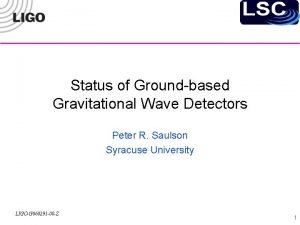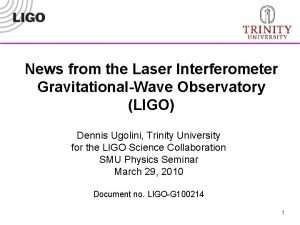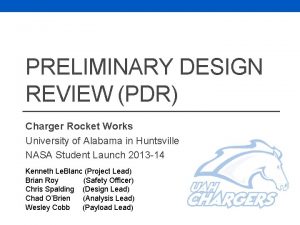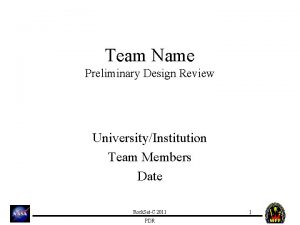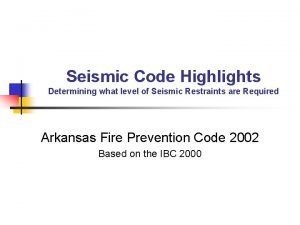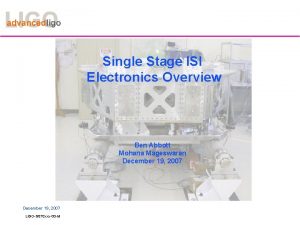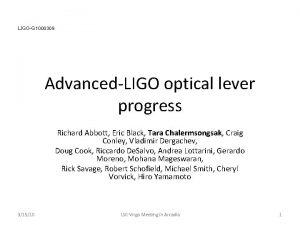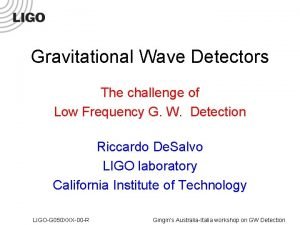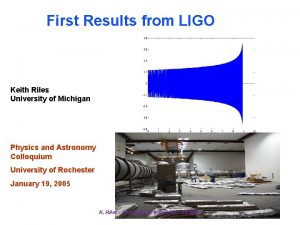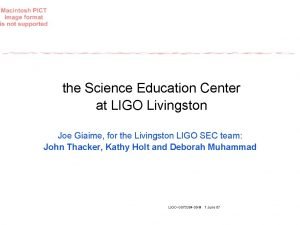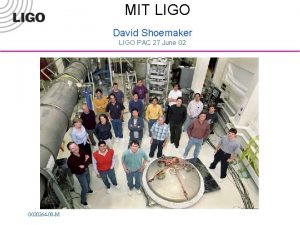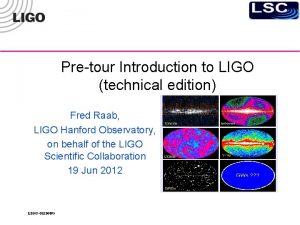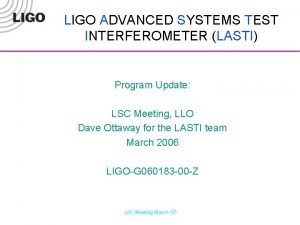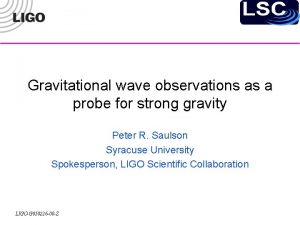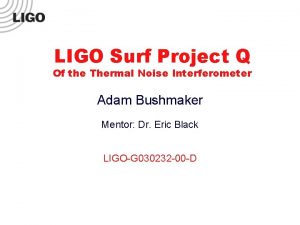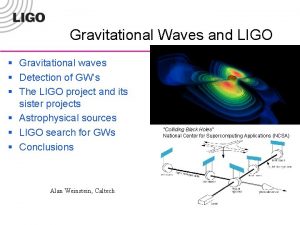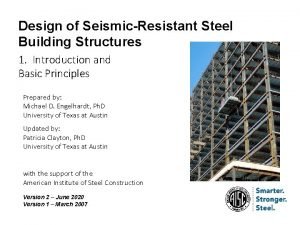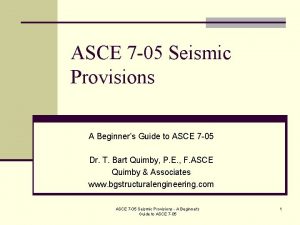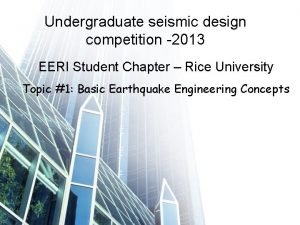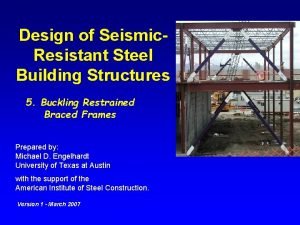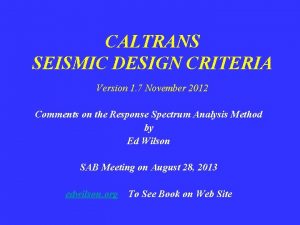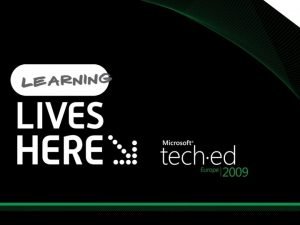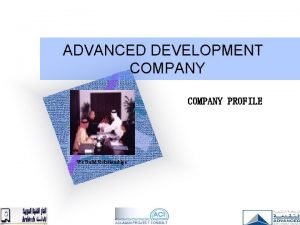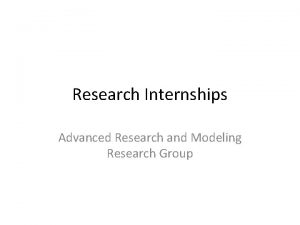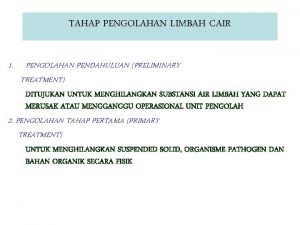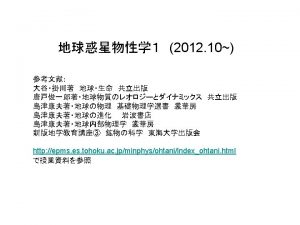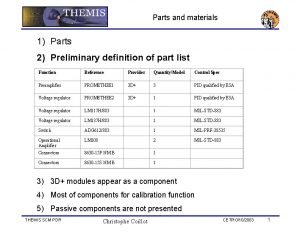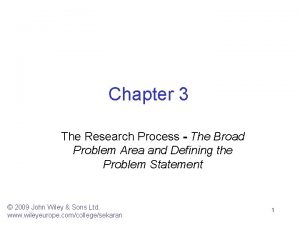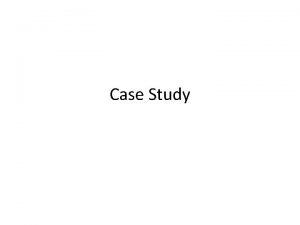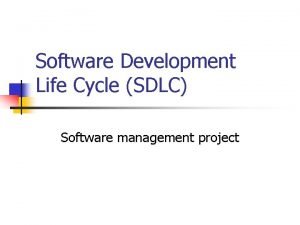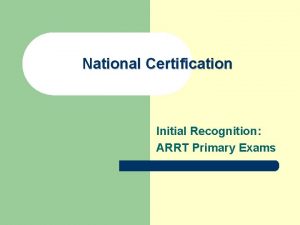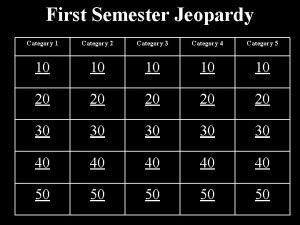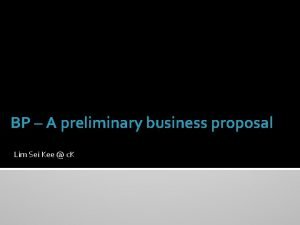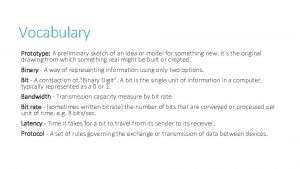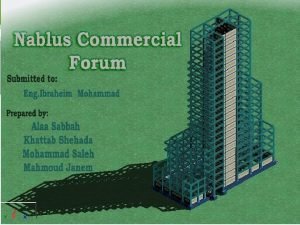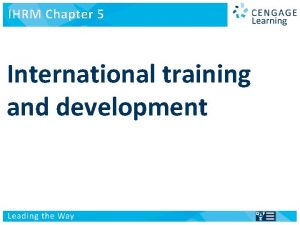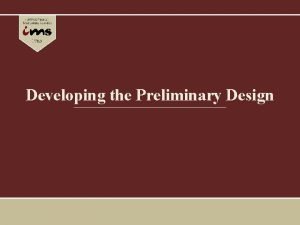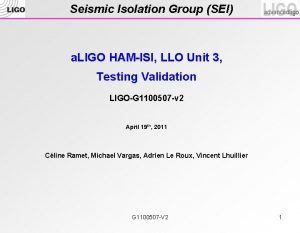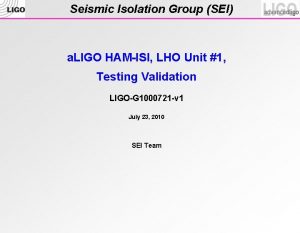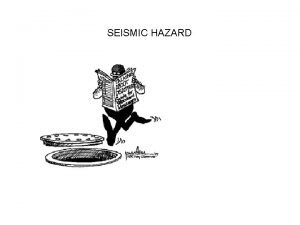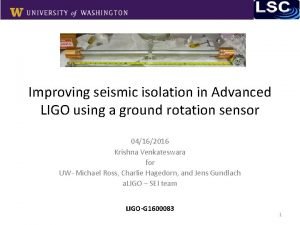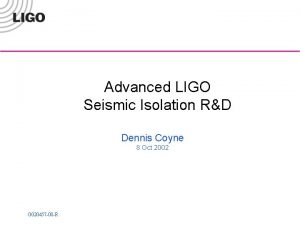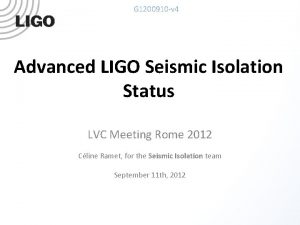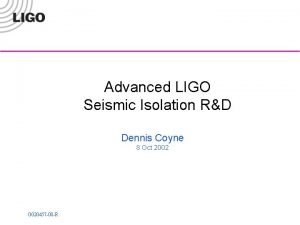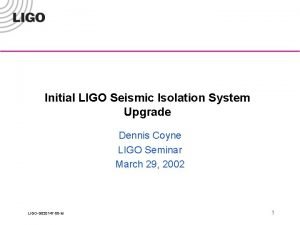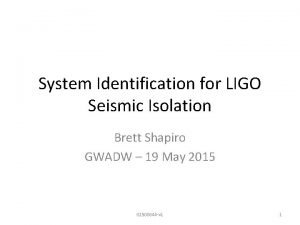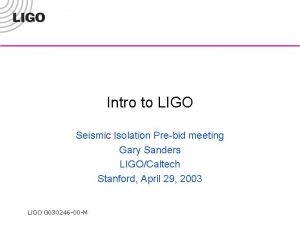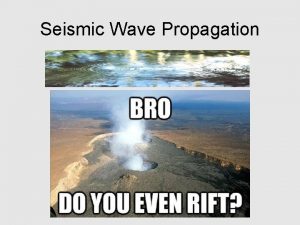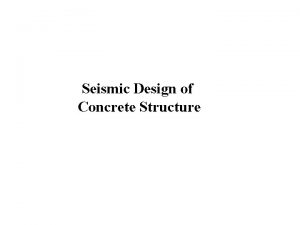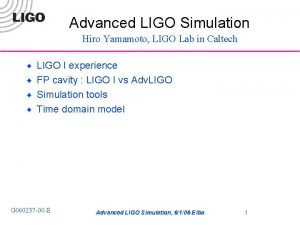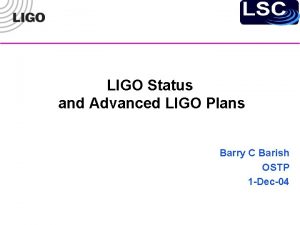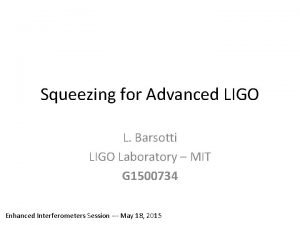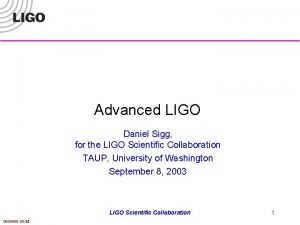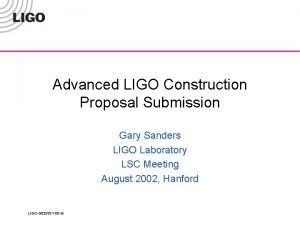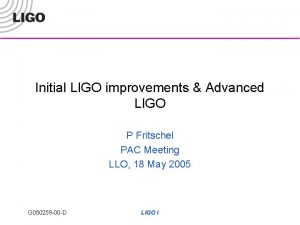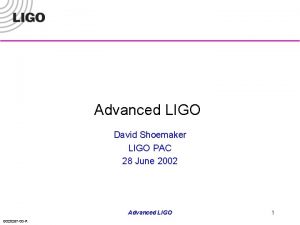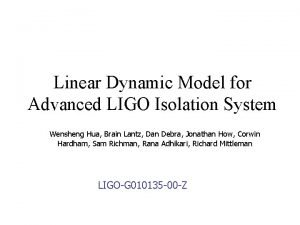Seismic Isolation Group SEI Advanced LIGO Preliminary Design




















































- Slides: 52

Seismic Isolation Group (SEI) Advanced LIGO Preliminary Design Review of the BSC ISI system - Overview Presentation LIGO-G 0900676 -v 3 July 10, 2009 B. ABBOTT, S. BARNUM, S. FOLEY, B. LANTZ, M. MAC INNIS, K. MASON, F. MATICHARD, R. MITTLEMAN, C. RAMET, B. O’REILLY, A. STEIN

1. Introduction BSC Internal Seismic Isolation (BSC-ISI) system ü A support structure (Stage 0) and Two suspended active stages (Stage 1 & 2). ü Will be installed for Advanced LIGO into the BSC chambers. ü A BSC-ISI system in each of the 15 BSC chambers. ü Optic table supports the test masses and beam splitters. ü Stage 0 will support the baffles ü Optical table is higher than I-LIGO (above the support tubes). Fig. 1: The BSC-ISI system installed on the support tubes of the HEPI-BSC. Fig. 2: BSC-ISI on its assembly stand at LASTI. 2

1. Introduction Both suspended stages and have 6 degrees of freedom: ü Blades provide the vertical flexibility ü Rods provide the horizontal one ü Suspension frequencies in the 1 Hz-7 Hz range ü Passive isolation from few Hz to ~ 100 Hz ü Active isolation in the 0. 1 Hz-20 Hz range. ü Active control positioning BSC-ISI as built for the prototype installed at LASTI • Stage 0 in violet • Stage 1 in cyan • Stage 2 in grey • Blades and flexure in yellow • Sensors in Red • Actuators in Pink 3

1. Introduction Historic ü Design requirements: May 2004 , LIGO-E 030179 -A, Design Requirements for the In-Vacuum Mechanical Elements of the Advanced LIGO Seismic Isolation System for the BSC Chamber. ü Initial design done by ASI. Presented in the document “Advanced LIGO BSC Prototype Critical Design Review, June 18 2004”. ü Technical memorandum delivered on October 15, 2004 and a transition meeting was held on January 18 -19, 2005. A critical review has been presented by the SEI team on January 2005, document G 050007 -00 -R. ü Analysis showed that this design should meet most of the design requirements as described on "Design requirements summary", page 4 -10 of “Advanced LIGO BSC Prototype Critical Design Review". The initial design is described in part 2 of this document. ü Requirements which were not met were waived by the SEI team. ü A prototype of the BSC-ISI was then manufactured by Arland Limerick. ü Assembled at MIT in 2006. 4 BSC-ISI Preliminary Design Review

2. Initial design Fig. 1: as built for the prototype installed at LASTI. Fig. 3: Stage 1 is suspended to the flexure rods. Fig. 2: Stage 0 with the Stage 0 -to. Stage 1 lockers and the Blade posts for Stage 1. Fig. 4: Stage 1 and Stage 2 fit together. Optical table on Stage 2. 5

2. Initial design Fig. 1: position of the instruments on stage 1. Fig. 3: position of the actuators on stage 1. Fig. 2: position of the instruments on stage 2. Fig. 4: position of the actuators on stage 2. 6

3. Prototype assembly and testing 3. 1 Dirty assembly and Testing (2006 -2007) Objectives ü Parts fit ü Measure the cross couplings ü Shimming process Conclusion Dirty assembly at LASTI ü Fit but referencing was unsatisfactory ü Actuators mis-positioned ü Adequate performance "X to Ry" : from 190 m. HZ to 60 m. Hz "Y to Rx" : from 190 m. HZ to 90 m. Hz Small actuators re-positioning 7

3. Prototype assembly and testing 3. 2 Cleaning (2007) Cleaning period permitted us to: ü Adjust the Cleaning space requirements and facilities : in-house chemical cleaning and oven space limitations determined. Large plate baking capability moved to LIGO. ü Adjust the cleaning process: Cleaning/baking procedures evolved. ü Solve some cleaning issues. ü Modifications, i. e. , Mounting holes of the optical table become through holes. Machining scraps Holes in the large plate Residual chemicals 8 BSC-ISI Preliminary Design Review

3. Prototype assembly and testing 3. 3 Clean assembly (Late 2007 - 2008) ü Careful attention was given to assembly issues. ü Wrote the assembly procedure ü Main problems identified and addressed ü A change design list established Friction Tooling Actuators Rods attachment 9

3. Prototype assembly and testing 3. 4 First commissioning (June 2008 - December 2008) Three major problems identified: ü The first deformation resonances were much lower in frequencies than required. ü The modal density at high frequencies was higher than expected. ü The plant was variant in time. High modal density Low frequency modes Plant variation 10

3. Prototype assembly and testing ü Plant variability was the main limit of the control performance. ü The control adjusted iteratively according to the plant changes ü Fully controlled the 12 degrees of freedom of the system. ISI System Performance 11/2008 BSC Global Performance 11/2008 ü Decided to stop the control development to investigate the sources of resonances and the plant variability. ü Necessary in order to make the control more robust and to improve the performance. 11

3. Prototype assembly and testing 3. 5 In Situ Testing ü Correlate some modes in the quad with some modes in the BSC -ISI transfer function ü Concluded we should continue the investigation on the use of damping. Quad-ISI modal testing ü Showed that the quad was neither the source of the high number of resonances nor the cause of the shifting modes. ü Continued the investigation by studying the other stages. Damping strut setup & Result on the Tech Demo at Stanford 12

3. 5 Testing and hardware modifications GS 13 pods ü GS 13 pods mounted cantilevered. ü Brackets have been machined and installed to lock the free end of the pods. ü Great improvement on the transfer functions for both the horizontal and vertical seismometers. ü Permanent solution to clamp the pods on both sides under development. Trim masses (counter weights) ü One of the biggest sources of resonances. Stacks to high, poor attachment. ü Brackets machined and trim masses have been re-machined in order to split these columns and attach them stiffely in various locations. ü Significant improvements obtained on both stages. ü Trim masses location and their attachment to the stages are being revised for Ad. L. GS 13 Attachment Counter weights Transfer function 13

4. Advanced LIGO Design LASTI Prototype ü ü 29 parts 967 lbs + hardware 330 screws ~38, 000 USD Stage 0 Advanced LIGO LASTI prototype Re-designed ü ü 2 parts 1186 lbs + hardware 106 screws ~42, 000 USD (Qty 15) 14

4. Advanced LIGO Design LASTI Prototype Re-designed ü Modal Analysis 1 st natural frequency 77 Hz 1 st natural frequency 133 Hz ü Static Analysis Nodal displacement contours plotted at the same scale (from 0 to 0. 225 mm) Bottom flexure rod displacement Post displacement in z x displacement y displacement # the x-y plane displacement LASTI Prototype Re-designed 1 2 3 mil -2. 3 -9. 0 10. 9 -1. 3 -6. 6 7. 0 mil -4. 6 1. 4 2. 9 -4. 1 1. 4 2. 2 mil 5. 2 9. 1 11. 3 4. 3 6. 7 7. 4 mil 30. 3 29. 8 27. 9 28. 3 28. 0 26. 5 % between z displacement 7. 85 6. 60 15

4. Advanced LIGO Design LASTI Prototype Re-designed ü ü ü Posts position maintained. ü Possible feed-forward from Stage 0 to Stage 1 ü 6 breadboards on the top ü Beam dumps attachment ü 6 eyebolts (on both parts) 3 Stage 0 -1 Blade posts 3 Stage 0 -1 Actuator posts 3 Stage 0 -1 Lock down posts 3 eyebolts for lifting Components on Stage 0 (only half of the breadboards are represented) 16

4. Advanced LIGO Design 4. 1 Stage 1 3 main objectives in the Stage 1 re-design: ü Re-designing the positioning of the parts. Cut outs are replaced by pins. ü Implementing the changes of the “design changes list”. ü Improving the stiffness where it can easily be made. Prototype Ad. L Design 17 G 0900461 -v 1, Stage 1 design review presentation.

4. Advanced LIGO Design Stage 1 – Parts positioning Fig. 1 Fig. 2 Hole Fig. 4 Slot Fig. 3 Hole Slot 18 G 0900461 -v 1, Stage 1 design review presentation.

4. Advanced LIGO Design Stage 1 - Items on the Change design list Item #6 – Part 2007827 Barrel Nut access Item #5 – Part 2007825 Holes too small Item #18 – Horizontal L 4 C Placement Item # 32 – 20007831 Holes alignment Item # 42 Tooling posts 19

4. Ad. L Design 4. 3 Stage 2 LASTI Ad. LIGO Changes for Advanced LIGO: ü Simpler Assembly ü Dowel Pins to Align ü Redistributed Mass for Better Stiffness 20

4. Ad. L Design Stage 2 - Optical Table LASTI Ad. LIGO Changes for Advanced LIGO: ü ü New Webbing Eliminate Blind Holes Add Vent Grooves Eliminate “Cut-outs” 21

4. Ad. L Design Stage 2 - Hex Walls LASTI Ad. LIGO Changes for Advanced LIGO: ü Fewer Plates ü Dowel Pins to Align ü Floating Brackets Couple Plates together 22

4. Ad. L Design STS-2 vs. Trillium 240 OBS STS-2 Diameter: 9. 5 in Dia. with locker. Mtrs: 13. 5 in Height: 9. 5 in Weight: 21 lb Trillium Diameter: 9. 5 in Height: 8. 9 in Weight: 21 lb Ad. LIGO Trillium & GS-13 POD, Internal Design Review G 0900466 (No Locker needed) 23

4. Ad. L Design STS-2 vs. Trillium 240 OBS Pods STS-2 Pod Base OD: 16. 0 in Top Hat OD: 14 in Height: ~11 in Weight: ~115 lb Feed. Thru OD: 4. 47 in Trillium Pod Base OD: 12 in Top Hat OD: 10 in Height: ~11. 5 in Weight: ~75 lb Feed. Thru OD: 4. 47 in Ad. LIGO Trillium & GS-13 POD, Internal Design Review G 0900466 24

4. Ad. L Design STS-2 vs. Trillium 240 OBS Pods Trillium Pod Diameter: 12 in Height: ~11. 5 in Weight: ~75 lb STS-2 Trillium Ad. LIGO Trillium & GS-13 POD, Internal Design Review G 0900466 25

Seismic Isolation Group (SEI) GS-13 Pod Original GS-13 Pod Diameter: 10. 0 in Height: ~15 in Weight: ~75 lb 2 Configurations Horizontal and Vertical Ad. LIGO Trillium & GS-13 POD, Internal Design Review G 0900466 26

Seismic Isolation Group (SEI) GS-13 Pod Original vs. New GS-13 Pod Original Diameter: 10. 0 in Height: ~15 in Weight: ~72 lb New, 1 Configuration Horizontal and Vertical 6/15/09 Ad. LIGO Trillium & GS-13 POD, Internal Design Review G 0900466 27

4. Final Design Actuators bracketing 1. sub-assembly over constrained with locking bar attached 2. gaps in all actuators are difficult to set once actuators are installed 3. Assembly order puzzle 4. For testing purposes the actuators need to be more easily isolated 5. Position sensor targets are not easily adjustable 6. Bracket connecting the horizontal fine actuator may not be a stiff connection 7. Access to the screws to install the fine actuators is very tight New Actuators and New Brackets - Both large (stage 0 -1) and small (stage 1 -2) have been re-designed - They have larger gaps between the coil and magnet. - External dimensions changed necessitating the design of new attachment brackets - The actuator assembly re-design encompasses the new size of the actuators - It addresses the concerns discovered during the assembly of the LASTI prototype. - An intermediary design was done to test the new large actuators at LASTI. - The performance and stiffness of the new actuators and brackets were satisfactory. Prtototype Advanced LIGO 28

4. Ad. L Design Remaining Steps ü Finish the individual sub-projects ü Flexure rods attachment ü Blades tooling ü Cabling routing ü Special tooling, Dial indicators ü Top assembly ü Drawings, tolerancing ü Documentation Schedule ü August 15, Sub-projects, tooling and top assembly ready. ü August 17 -19, internal review with the SEI team. ü August 19 -31, final adjustments after the internal review. ü September 1 st, start working on the drawings and documentation. ü October 1 st, we start to put together the documentation for the FDR. ü October 15, the documentation is posted for the FDR. 29

Nanometrics Trillium 240 (T 240) ü Low-frequency inertial sensors ü Used On stage 1, where more of the low frequency control is done ü Intended to replace the Streckeisen STS-2 originally specified ü The T 240 and the STS-2 have similar size, weight, cost and performance. ü The T 240 can be purchased. STS-2 are on 18 month delivery schedules ü The T 240 has no locking motors. ü New pod smaller, weigh smaller (from 115 to 70 lbs) ü We recently measured and compared T 240 with STS-2 s. No significant noise difference. Testing sensors at the ETF Noise estimates of the T 240 mounted on the ETF Tech Demo, and compared with 2 STS-2 s 30 See T 0900318, ‘Noise testing of the Nanometrics Trillium 240 on the Tech Demo’

Sercel L-4 C Inertial Sensors ü High frequency inertial sensors used on Stage 1. ü Passive geophone with a 1 Hz natural frequency. ü We equip it with a local preamplifier placed into a vacuum pod. ü Have been in use on the ‘Rapid Prototype’, Tech Demo and HEPI. L-4 C Noise performance measured with witness L-4 Cs on the second stage of the Tech Demo. A discussion of the noise measured from a set of witness L-4 Cs on the table of the Tech Demo is described at http: //ligo. phys. lsu. edu: 8080/SEI/679. 31

GS-13 Inertial Sensors ü Used On stage 2, the stage closest to the optic. ü Moving coil seismometer with a 1 Hz natural frequency. ü We replace the internal electronics board with one of our own design [D 050358 -01]. ü It makes this device the lowest noise 10 Hz commercial seismometer available today. ü A vacuum ‘pod’ has been designed to contain the instrument. ü In use on the prototype and in the observatories on the HAM 6 -ISI platforms. ü New units will have custom flexures so the locking motors are not needed. ü All units will be tested according to our specifications at the manufacturer before shipping and then again at LLO after the new flexures are installed. Noise performance of the GS-13 s. This measured noise will allow us to reach the BSC requirements. üInstrument modifications, testing, and pod assembly for the HAM 6 -ISI are described in the ‘GS-13 Seismometer Assembly Procedure’ [E 080086]. üThe flexures and testing are described in LIGO-T 0900089, ‘GS-13 Seismometer Flexure Report’. 32

5. Sensors and actuators Capacitive Sensors üThe capacitive displacement sensors are sold by ADE. üThey include a UHV compatible head, designed for LIGO, and a readout board. üThe sensor range for the stage 0 -1 sensors is +/- 1 mm, noise floor around 6 e-10 m/rt. Hz. üThe sensor range for the stage 1 -2 sensors is only +/- 0. 25 mm, noise about 1. 5 e-10 m/rt. Hz üAll the hardware for both stages is identical üThe only difference is the calibration and the matching capacitors in the readouts. üThe heads are cleaned and baked at low temperature, require a special strain relief for the cable. üHeads are provided with special protective stops. Actuators ü Custom actuators designed and fabricated for the ISI platforms by a commercial design firm, PSI. ü Coil actuators maximize the drive linearity and minimize generation of external magnetic fields. ü Set of the stage 0 -1 actuators have been built and installed for the HAM 6 -ISI system. The stage 1 -2 actuators are of a similar design, but are a bit smaller. ü A set of these actuators has been delivered to MIT. ü Since these actuators have potted coils, special cleaning procedures have been developed [E 080497] to clean some parts of the actuators before they are fully assembled. The final actuators are cleaned and baked. Actuator issues: ü Wire connectors made of PEEK terminal block on the actuator will probably be modified by adding a crimp pin to the wire, and replacing the slotted bolt on the terminal block with a hex-head bolt. ü Kapton-based potting compound used for the HAM 6 installations has been discontinued by the manufacturer and replaced with an upgraded material (PI-2525 resin). The new material is currently being investigated by the LIGO Lab. 33

6. Electronics Entire system made up of a set of - Electronics chassis - Some timing chassis - The “Blue Box” - Computer system. - Interconnection of all of the electronics chassis in schematic LIGO-D 0901301 -v 1. ISI Interface Chassis - Gathers all of the signals from GS-13, the L 4 C and Capacitive Position Sensors - Interfaces them with the computer via an Anti-Alias filter chassis. - Installed in the LASTI ISI system - Some modification is needed for use in Advanced LIGO (See details in LIGO-L 0900118). ISI Coil Driver - High-current driver receives signals from the computer via an Anti-Image filter chassis. - Provides high current signals to the ISI actuators. - The design works well. - Minor changes are being done to make the chassis easier to put into production. 34

6. Electronics Binary I/O Chassis - Essentially a patch-panel that takes one connector that goes to the Binary I/O card - Binary Out signals go to the ISI Interface chassis to control gain and filter settings - Binary In signals come from fault monitors in the Coil Driver chassis. - Simple board but it will have to be redesigned to interface with the newer style of Binary I/O. Anti-Alias Chassis - A low-pass filter for all incoming signals - Cutoff frequency set so that signal higher than the Nyquist frequency don’t alias down into the passband. - Boards have 32 channels corresponding to the 32 -channel Analog to Digital Converters to which they connect. - More details on revisions in LIGO-L 0900118. Trillium T 240 Interface Chassis - Needs to be designed. Should resemble the STS-2 Interface chassis in use in the HEPI system. - Will interface with the Trillium T 240 and send signals to computer via Anti-Alias filter, and ADC board. - Will also receive binary output signals that switch some of the seismometer’s functionality. 35

6. Electronics Manufacture and Production - All chassis will be manufactured at a turn-key external company. - They will order the parts, stuff the boards, assemble the chassis, and deliver the whole thing ready for testing - We are currently examining several of these companies for the manufacture of HEPI electronics, and will select one at the end of a bidding cycle. Setup and Testing of the Electronics - Boxes and several small boards have been made to help with the task. - The STS-2/GS-13 Tester boxes. - Emulator box connected in the place of an in-vacuum seismometer. Allows testing all of the wiring, and computer system without endangering an expensive seismometer. - A switch board that emulates the functionality of the binary I/O modules, so gains and whitening can be set right at the rack, - Several inline breakout boards that go inline with the cables, and allow you to clip onto any wire inside, and check the health of the signal there. - Documentation on system test procedure. A set of “quick start guides” for quick overview of functionalities and “care and feeding”. A sample system test procedure listed LIGO-L 0900118. 36

7. Cleaning, Leak check, Assembly, Storage, and Installation. Cleaning - Parts will be cleaned to LIGO specifications according to LIGO-E 960022. - Cleaning and baking of parts except the large plates will take place at LHO, LLO and CIT. - Large plates will be chemically cleaned by an outside vendor and air baked at LHO and LLO. - Special procedures, for the actuators and the capacitive position sensors (used for the E-LIGO) - Vacuum pods for the Trillium, GS-13 and L 4 -C seismometers will be cleaned and baked. - Vacuum pods are then filled with a neon tracer gas for leak detection. Unclear if: - If the tracking of the clean and bake of parts will be done using cleaning travelers as in the past - Or whether this will be replaced by the new JIRA inventory control system. - This is a systems level decision rather than an SEI level decision. 37

7. Cleaning, Leak check, Assembly, Storage, and Installation. Leak checking - Sensors enclosed in vacuum sealed pods - Concerns with contamination of the vacuum due to a leak - Concerned outline in T 0900192. We have to adopt a zero-tolerance approach. - Mainly driven by the GS-13 instrument which uses several substances. - Each sensor will be tested prior to being installed in a vacuum pod. - During assembly the pod is filled with at least 0. 1 atmospheres of Neon gas. - This gas is used to identify leaks after assembly. - We leak test the pods in vacuum oven. - All pods will be assembled at the Livingston site. - Pods which are shipped to Hanford will be leak-tested at Hanford prior to installation - We are also investigating the use of a more robust vacuum feed-through. - Assembly documents exist for the L 4 -C (T 080261) and the GS-13 (T 080086) - Based on our experience (BSC-ISI prototype at LASTI and HAM-ISI). - Another assembly procedure will be done for the Trillium T-240. 38

7. Cleaning, Leak check, Assembly, Storage, and Installation. Assembly ü Assembly procedure of the prototype 0 ü Will be fully updated along with the final design. Storage ü Once assembly and testing is complete the BSC ISI will be prepared per LIGO document E 960022 -B ü Will be placed in a modular container similar to the container designed for the HAM ISI. Installation ü Described in LIGO-L 0900118 ü Done at LASTI ü Installation procedure and hazard analysis will be written before the FDR HAM ISI Storage Container BSC ISI Instalation at LASTI 39

8. BSC-ISI Control Strategy ü Feedback control approach is described on the diagram below. ü The motion of the stages are coupled to each other ü The stages can be controlled independently 40

8. BSC-ISI Control ü For each stage, the control is based on the use of 6 independent SISO loops. ü The control is done in the basis of the general coordinate system: X, Y, RZ, Z, RX, RY. ü X and Y are aligned with the arms of the interferometer. ü Position sensors are used to measure the relative position of the stage ü A Local to General coordinate change of basis matrix ü Seismometer to measure the inertial motion ü Seismometer signal sensors are first used to damp the suspension resonances ü Complementary filters are then used to blend the position sensors and the seismometers. ü The position sensors signal is filtered by the low pass and ü The seismometer is filtered by the high pass. ü The two signals are summed resulting in a super sensor (block 2 on the diagram above). ü Finally a control filter is applied to the super-sensor to provide loop gain. ü Unity gain frequency goal is 30 Hz, the phase margin to 30 degrees. ü Control steps are detailed in document LIGO-T 0900250. 41

8. BSC-ISI Performance Active control isolation ü Motion of the optical table measured in the X direction with the GS 13. ü The black curve shows the motion of the table when the control is off. ü The Blue curve shows the motion of the table with a high frequency blend on both stages(0. 7 Hz). ü "X to Ry" and "Y to Rx" motions are decoupled using a tilt decoupling matrix. ü Red curve: the blend frequency has been lowered to 0. 2 Hz on stage 2. ü Purple curve, the sensor correction has been turned on. ü At low frequencies (around 0. 1 Hz) there is very little motion amplification. ü The isolation starts as low as 0. 1 Hz which is good. ü The isolation at 1 Hz is close to a factor of 100. ü The control provides isolation up to 20 Hz, which is good. 42

8. BSC-ISI Performance Global isolation (Active & Passive) - The ground motion is shown in Black. It is measured with a STS. - The HEPI motion is shown in Blue. It is measured with HEPI L 4 Cs. - The motion of stage 2 when the control is off is presented in Red - The motion of stage 2 when the control is on is presented in Purple - The relative requirements are presented in Grey 43

8. BSC-ISI Performance ü Predictive noise budget for Advanced LIGO, the document G 0810021 -v 1 ü At 17 Hz the seismic noise was below the other sources of noise. ü Estimation based on the BSC-ISI performances as of November 2008. ü Performance improved since 44

8. BSC-ISI Performance Control commissioning at LASTI: - Stage 1 blend frequency will be lowered - HEPI feedback control will be restored - Sensor correction from the Ground to HEPI will be implemented Those steps have already been done in the past and have proven to significantly improve the performance. Some other steps not tried before will also be tested: ü Sensor correction from HEPI L 4 C to Stage 1 ü Feedforward from HEPI to Stage 1 at high frequencies (10 Hz-20 Hz) ü Feedforward from Stage 1 to Stage 2 at high frequencies (10 Hz-20 Hz) 45

Ideas for improving performance < 0. 1 and 10 -15 Hz #1 Increase of the sampling frequency ü Time delay reduction, smaller loss of phase from anti aliasing and anti image ü Low or no extra cost #2 Feedforward using L 4 C on stage 0 ü Advantages: - path more direct than from HEPI to Stage 1. Less local deformations, better performance. - source of feedforward well decoupled from the action (not true for a feedforward from stage 1 to stage 2). ü Will be tested at LASTI : L 4 Cs will be mounted on Stage 0 of the prototype ü Cost : $6700/unit (L 4 C, preamp, feed through, pod, cable, flange) + Interface chassis ~ $30 k/per chamber #3 Sensor Correction & Feedforward using low frequency 3 axis instruments on cross beams ü Guralps, Trilium Compact ($7060/unit) Or ü Advantages: - Out of vacuum - Low frequency instruments permitting sensor correction (micro seismic improvements). - Could be combined for tilt subtraction in the horizontal instruments ü Will be tested at LASTI ü Cost 46

9. Procurement Order placed or ready for procurement: $3. 9 M of $17. 43 M Total (22. 4%) Description Proc, . ID Status GS-13 Seismometers SI-165 Order Placed L 4 -C Seismometers SI-175 Ready for procurement L 4 -C Pods SI-193 Ready for Procurement ADE Position Sensors SI-162 Ready for Procurement Large Electromagnetic Actuators SI-170 Order Placed In-vac Cabling SI-164 Ready for Procurement Actuator Coil Drivers SI-300 Ready for Procurement In pod wire harnesses SI-165 Ready for Procurement Ready between the PDR and the FDR : $2. 03 M (11. 7%) Description Proc, . ID Status GS-13 Pods SI-193 Design inc. as part of this PDR – 7/30/09 Trillium 240 OB Seismometer SI-107 b Specs inc. as part of this review – 7/15/09 Trillium 240 OB Pods SI-193 Design inc. as part of this PDR – 7/30/09 Small Electromagnetic Actuators SI-170 Design inc. as part of this PDR - 8/30/09 Springs Material 8/30/09 47

10. Remaining Steps to the FDR List of things we are concerned with and working on: Testing ü Balancing of stage 1, Shimming ü Tilt on vertical seismometers ü High frequency performance ü Ground to HEPI sensor correction Design ü Schedule ü Late projects (Rods attachment, Blade loading) ü Actuators, GS 13 & Trim masses attachment 48

10. Remaining Steps to the FDR Design - The Stage 0, Stage 1, Stage 2, Actuators Brackets and Seismometers sub-projects are on time according to the re-design schedule M 0900175 -v 1. - We are going to start the detailing phase for those project. Our objective is to have the drawings ready for the FDR. - We are behind schedule on the Flexure Rods sub-project. More manpower will be affected to this project to bring it back on time. As for the other subprojects, our objective is to have the drawings ready for the FDR. - We start working on the tooling re-design like it was schedule in M 0900175 -v 1. Testing - The shims on the prototype at LASTI will be adjusted to lower the amount of trim masses used on stage 1. 500 pds are currently use which results in concentrated masses creating local deformations. Control - The control commissioning continues as described previously. Documentation The following documents must be prepared before the FDR: - Assembly procedure and hazard analysis. - Installation procedure and Hazard analysis. - First article testing plan 49

10. Remaining Steps to the FDR 50

10. Remaining Steps to the FDR 51

10. Remaining Steps to the FDR 52
 Seismic isolation
Seismic isolation Seismic isolation
Seismic isolation Preliminary design review example
Preliminary design review example Pdr preliminary design review
Pdr preliminary design review Preliminary design review template
Preliminary design review template Seismic design category
Seismic design category Where was ben abbott born
Where was ben abbott born Ligog
Ligog Ligo challenge xxx
Ligo challenge xxx Ligo detections
Ligo detections Ligo science education center
Ligo science education center Ligo science education center
Ligo science education center David shoemaker ligo
David shoemaker ligo Ligo
Ligo Ligo
Ligo Ligo
Ligo Caltech ligo surf
Caltech ligo surf Ligo
Ligo Qe steel buildings
Qe steel buildings Vertical discontinuity
Vertical discontinuity Seismic design competition
Seismic design competition Design of seismic-resistant steel building structures
Design of seismic-resistant steel building structures Caltrans seismic design criteria
Caltrans seismic design criteria Group policy change management
Group policy change management Advanced development group
Advanced development group Advanced research group
Advanced research group Preliminary budget
Preliminary budget Preliminary treatment adalah
Preliminary treatment adalah Preliminary survey
Preliminary survey P 波
P 波 Parts of preliminaries
Parts of preliminaries Mla research paper outline example
Mla research paper outline example Preliminary interview
Preliminary interview Identify a broad problem area examples
Identify a broad problem area examples Wilson company prepared the following preliminary budget
Wilson company prepared the following preliminary budget Mga bahagi ng pamanahong papel
Mga bahagi ng pamanahong papel Preliminary graphics examples
Preliminary graphics examples Goto/sdle
Goto/sdle Preliminary thesis statement
Preliminary thesis statement Primary marksmanship instruction
Primary marksmanship instruction Pearson vue arrt
Pearson vue arrt Image development strategies
Image development strategies A preliminary synopsis of a film's action is called a
A preliminary synopsis of a film's action is called a Determine junktrader’s preliminary net income.
Determine junktrader’s preliminary net income. An oxidizing agent milady
An oxidizing agent milady Preliminary business plan
Preliminary business plan Preliminary prototype
Preliminary prototype Preliminary audit
Preliminary audit Preliminary outline
Preliminary outline Which type of melanin lends black and brown colors to hair?
Which type of melanin lends black and brown colors to hair? International market selection model
International market selection model Expatriate training in ihrm
Expatriate training in ihrm Preliminary objectives
Preliminary objectives
